 Deutsche Version
Deutsche Version


Introduction
Can creativity be safeguarded in chess? Arguably, too much focus is on computerized opening preparation. It also damages creativity the way in which amateurs try at all costs to avoid theoretical paths (due to its advanced development). For example, the French Exchange, and the Queen Pawn opening, will become boring in the end. As a complement to Fide chess, I suggest the following method as a remedy. The various relocation methods allow the players optionally to relocate king and/or queen before play begins, whilst retaining the castling rights. (The rooks remain in their position.) The players may abstain from this should they prefer the standard setup. It is a cogent method of rearranging the initial position to enhance opening ramification, while allowing the players to remain in control. The resultant positions deviate marginally from the standard position and would be experienced as natural by most chess players.
Relocation
The rules are like standard chess except that the players may, before play begins, swap places of the king + queen and another piece except the rooks. Thus, when the king is swapped (relocated ), the other piece (the relocatee ) ends up on the king’s square. When the queen is swapped, the relocatee ends up on the queen’s square. One restriction is that the bishops mustn’t end up on the same square colour, and the king cannot become a relocatee (i.e. swapped by the queen).
Note that Black always begins whereas White determines the resultant position. This allows White to choose a strategy of his liking. The reason why White is allowed to have the final word is because Black has effectual defensive measures at his disposal. White is somewhat recompensed for this; but it doesn’t mean that a clearly advantageous position can be achieved. It merely gives him the opportunity to decide strategical aspects of the forthcoming battle. This is how it works in today’s chess. Generally, it is White that sets the agenda and has the strategical initiative.
Castling
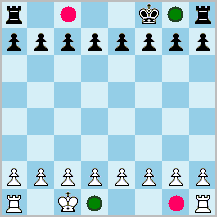
The castling rules are simple and derive from Chess960. King and rook end up on their usual squares. The only difference is that the king can make longer leaps than usual (or shorter, or none at all). All squares between king and rook must be empty, and all squares between the king and its landing square must be unthreatened. Neither of the pieces must have moved before. In this example White can make a queenside castle (O-O-O) by simply moving the rook to d1 (green dot). He may also castle on the kingside (O-O) by jumping all the way to g1 (red dot), while the kingside rook, as usual, ends up on f1. Black may castle on the kingside (O-O) by moving the king rightward to g8 (green dot), or castle on the queenside by jumping to c8 (red dot).
Curtailed castling: as an alternative rule, the king may retain its castling right only if it is placed on any of the four central files. In other words, if the king is positioned on the g or b file, the castling right is forfeited. After all, such a safety move brings certain advantages, so it should cost something. This restrictive rule would also enhance strategical predictability. This rule is at least applicable to variants with non-mirrored kings. (Alternative curtailed castling: in mirrored king variants, if the king is placed on the g or b file, castling is restricted to the side on which the king is placed.)
Six relocation methods
Time will tell which one of the below variants is the best alternative. Note that there is a link to respective variant. A Zillions program is available for each variant. There are also email presets, which enable play online or per email. Alternatively, you could easily try out the diverse relocation variants if you own a program that can handle Chess960 (FRC) castling. The diverse variants allow the king to swap with any piece except the rook. (It is possible to restrict this rule so that it’s only allowable to swap with the queen. Thus, only positions with central kings will be generated.)
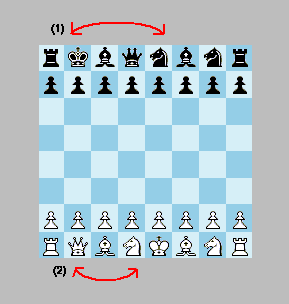
Relocation Chess. Both players can relocate either the king or queen. Black begins by making the initial swap. Alternatively he can choose to leave the position as it is. The white player then has the option to relocate his king or queen, whereupon he starts the game by making the first move. This is the simplest of my proposed relocation methods; it only needs two half-moves to execute. Nevertheless, it can produce 64 different positions. In this example, Black has relocated the king to b8 and the relocatee to e8. White has relocated the queen to b1, and the relocatee is thus placed on d1.
Chess-9 is a reduced variant, where only 9 positions can be generated.
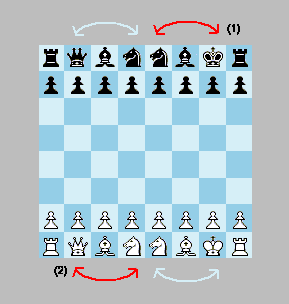 Placement Chess. Contains only mirrored positions. Black decides the positions of the kings, while White decides the positions of the queens. Black begins by swapping his king. Alternatively he can forgo this possibility. White is compelled to mirror Black’s swap. The turn is still with White, who can now relocate the queen, if he so wishes, and Black then mirrors this. Next white starts the game. Diagrams of the 20 possible positions can be viewed here. There is also a reduced variant with 8 positions (here) in which black may only relocate the king to d8. In this position, Black has relocated the king to g8 and the relocatee to e8. White is compelled to mirror this move. He has then relocated the queen to b1 and the relocatee to d1. Black has mirrored the latter relocation.
Fischer Placement Chess is an extended version where the queen is also allowed to swap with a rook, thus generating 25 modest Chess960 positions (here).
In Chess4 only the queens can swap.
Placement Chess. Contains only mirrored positions. Black decides the positions of the kings, while White decides the positions of the queens. Black begins by swapping his king. Alternatively he can forgo this possibility. White is compelled to mirror Black’s swap. The turn is still with White, who can now relocate the queen, if he so wishes, and Black then mirrors this. Next white starts the game. Diagrams of the 20 possible positions can be viewed here. There is also a reduced variant with 8 positions (here) in which black may only relocate the king to d8. In this position, Black has relocated the king to g8 and the relocatee to e8. White is compelled to mirror this move. He has then relocated the queen to b1 and the relocatee to d1. Black has mirrored the latter relocation.
Fischer Placement Chess is an extended version where the queen is also allowed to swap with a rook, thus generating 25 modest Chess960 positions (here).
In Chess4 only the queens can swap.
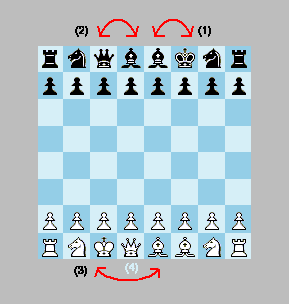
Regroupment Chess. Black begins by swapping his king. Alternatively he can forgo this possibility. The turn is still with Black, who can now relocate the queen. When White has made his king + queen swap (or dispensed with this possibility) he starts the game. It is possible for the king to swap with the kingside bishop, but this necessitates that the queen be swapped with one of the bishops so that the bishops end up on different colours. The method produces 484 positions. Here, Black has relocated the king to f8 and the relocatee to e8. The queen is swapped with the queenside bishop. White has relocated the king to c1 and the relocatee to e1. He has dispensed with his queen relocation move by letting it stay on d1.
Note! Multi-chess is a reduced version that contains 57 positions. With the exception of the standard position, all are non-mirrored. Rooks and knights are always in their standard positions. Thus, the setups are always harmonious.
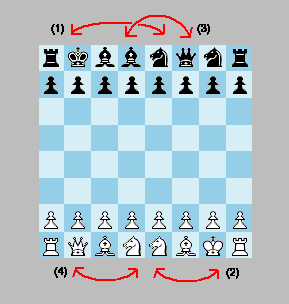
Configuration Chess. Both players, in turn, relocate first the kings and then the queens. Black begins by swapping his king. Alternatively he can forgo this possibility. The white player then has the option to relocate his king. After this the turn goes back to black. The queens can now optionally be relocated. When White has made his queen swap (or dispensed with it) he starts the game. The method produces 400 positions. In this example, Black has relocated the king to b8 and the relocatee to e8. White has relocated the king to g1 and the relocatee to e1. Black has then decided to relocate the queen to f8. White, finally, has relocated the queen to b1, and the relocatee is thus placed on d1.

Arrangement Chess. The king positions are mirrored, but the queens are positioned freely. Black begins by swapping his king. Alternatively he can choose to leave the position as it is. The white player is compelled to mirror Black’s swap. After the kings thus have been swapped, Black can now relocate the queen, if he so wishes. Next White relocates his queen and immediately starts the game by making the first move. The method produces 100 positions. In this example, Black has relocated the king to g8 and the relocatee to e8. White mirrors this move. Black has then relocated the queen to e8 and the relocatee to d8. White, finally, has relocated the queen to b1 and the relocatee to d1.
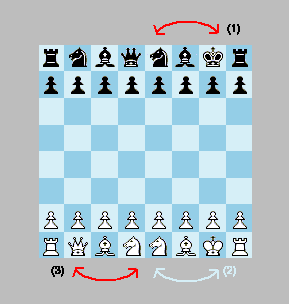
Regiment Chess. The king positions are mirrored, decided by Black. But only White can relocate the queen. Black begins by swapping his king. Alternatively he can forgo this possibility. The white player is compelled to mirror Black’s swap. After the kings thus have been swapped, White can now relocate the queen, if he so wishes. Then he immediately start the game by making the first move. The method produces 20 positions. In this example, Black has relocated the king to g8 and the relocatee to e8. White mirrors this move. The turn remains with White, who has relocated the queen to b1 and the relocatee to d1.
Discussion
Although orthochess is very complex, the variance is not good enough in today’s computerized chess. This creates a tedium in opening play, because players will again and again find that their variants aren’t playable. They won’t unfold into a creative struggle, but turn out to be drawish, or advantageous to the other party. Hence they are forced to learn long and tedious theory in order to play serious chess. Today’s grandmasters must be theoretically well-prepared rather than intuitive and creative. One can’t really play the King’s gambit anymore, and combine like Adolf Anderssen. There is no point, anymore, to play the Closed Sicilian, à la Spassky, or the Vienna Game.
In fact, amateurs, too, often give up opening variants which aren’t perfectly adequate because the opponents can prepare against them. Moreover, theoretical development has led to a form of “theoretical phobia,” when amateurs habitually try to avoid theory at all costs (e.g., they tend to play the French Exchange, etc.). This is equally damaging to chess creativity.
Had orthochess been somewhat more complex, then a greater choice of opening lines would be at their disposal. In this way professional chess could remain creative and stimulating. This would be beneficial to chess at large and ensure that it won’t lose in popularity. In that way the game may attract other categories of people who aren’t particularly theoretical, nor interested in becoming memorization artists. They can become strong players anyway. My proposal is to enhance traditional chess by a relocation procedure, whilst keeping the option to play the standard position. It should be viewed as a complement to orthochess.
Clearly, this must be good for young people undergoing chess training. In this way they can avoid getting stuck in opening studies. In a strong tournament, on the other hand, one can consider playing standard chess in the earlier rounds, and use relocation rules in the final rounds. The following discussion provides a good example of today’s dilemma.
The best opening move is 1.e4. Suppose that Black answers 1...e5. Obviously, there is a lack of strong alternatives to 2.Nf3 Nc6 3.Bb5 a6 4.Ba4, etc. etc. So there are no good substitutes for the long variations in Ruy Lopez, whereas the alternatives are inferior. Italian game (Giuoco Piano) isn’t really dangerous anymore, and one can’t put one’s trust in the King’s gambit. The Ponziani doesn’t promise much.
It’s becoming less and less worthwhile to play inferior variants, due to opening preparations. If only there existed an equally good opening system against 1...e5, it would be a great relief. Due to a slight shortfall of variance in chess, it leads to the necessity of analyzing and playing professional opening lines to the umpteenth move. There is nothing essentially wrong in such a scientific approach, but it is slightly frustrating from a creative point of view.
Of course, 1...e5 is not the only serious defence; Aljechin is a good alternative, as well as the Sicilian. I just wish to shed light on a frustrating quality of the game, i.e. that after 1...e5 you don’t really have the same freedom of moves as you had in the beginning of the 20th century. Theory is narrowing down because it’s not worthwhile to choose the King’s gambit when playing against a prepared opponent. Comparatively, the feeling of freedom must have been unimaginable when the American trapper, in the 18th century, moved into Western territory. Today, people travel along the highways, just as in modern chess.
Conclusion
In my proposed “relocation variants” theoretical study remains a meaningful occupation, although its impact is reduced. This is a major departure from Chess960. The foremost difference is that the player can himself decide the setup of his own pieces, whereas Chess960 is wholly randomized. Additionally, the positions are “natural” in appearance, with rooks always on the corner squares (only in Fischer Placement Chess one rook can be relocated) and the bishops always on different colours on the four central ranks (i.e. never on the b or g file). Hence the bishops and rooks must be developed before they can have any impact, just as in standard chess. It is logical to relocate the king first since the positioning of the queen can be informed by the king’s position. Only in Placement Chess and Fischer Placement Chess, are all positions mirrored. Unlike randomized Chess960, the relocation idea should be acceptable to most chess players. It is an authentic concept. Julius Caesar won the battle of Pharsalus thanks to redeploying his troops before the battle. (All my relocation variants may be freely used, also for commercial purposes.)
© Mats Winther, 2009 May.
Addendum
☛ For another interesting alternative to standard chess,
which introduces modest changes, see Adjutant Chess, here.
☛ All the relocation variants in one single program: Relocation Chess Variants.
☛ Don’t miss my other chess variants.